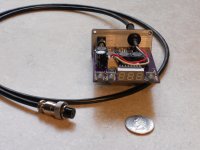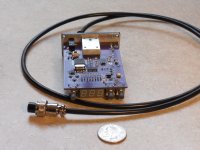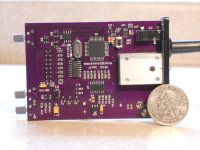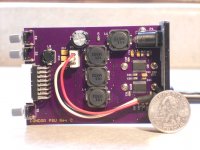Latest version of 3 phase controller
This is the latest interation of the 3 phase BLDC motor controller. I was able to apply a few things I learned doing the SG4 to this design, and eliminate some (expensive) hardware and freed up some real estate in the process. I was able to combine the 25W amp with the 3 phase controller onto one small PCB that fits in the Eagle controller extrusion. The whole power supply is about the size of a pack of cigarettes, but drives a 12W motor with 2-3x the torque of a Hurst 300 RPM motor. The motor is much quieter than an AC synch motor as there is zero cogging and the bearings are much more precise. The controller can drive the motor from 1Hz (30 RPM motor, 1.667 RPM platter) to 64Hz (1920 RPM motor, 106.667 RPM platter), so I can do 33/45/78 RPM with one pulley, loads of torque and no burn out on the belt at all.
The circuit is essentially the same as the previous version, except that I am developing all 3 phases in the uP. It still has the same frequency resolution as the previous version and still accepts feedback from the RoadRunner tach so it holds the platter speed to within ±0.005 RPM. I was also able to get the BOM cost below $75.
I need to recalibrate the frequency/voltage/phase function which should only take an afternoon to do. After that, I plan on measuring the torque at various speeds and compare the results against the Hurst motors. I built a jig that will hold either motor and read the torque out directly in oz-in.
This is the latest interation of the 3 phase BLDC motor controller. I was able to apply a few things I learned doing the SG4 to this design, and eliminate some (expensive) hardware and freed up some real estate in the process. I was able to combine the 25W amp with the 3 phase controller onto one small PCB that fits in the Eagle controller extrusion. The whole power supply is about the size of a pack of cigarettes, but drives a 12W motor with 2-3x the torque of a Hurst 300 RPM motor. The motor is much quieter than an AC synch motor as there is zero cogging and the bearings are much more precise. The controller can drive the motor from 1Hz (30 RPM motor, 1.667 RPM platter) to 64Hz (1920 RPM motor, 106.667 RPM platter), so I can do 33/45/78 RPM with one pulley, loads of torque and no burn out on the belt at all.
The circuit is essentially the same as the previous version, except that I am developing all 3 phases in the uP. It still has the same frequency resolution as the previous version and still accepts feedback from the RoadRunner tach so it holds the platter speed to within ±0.005 RPM. I was also able to get the BOM cost below $75.
I need to recalibrate the frequency/voltage/phase function which should only take an afternoon to do. After that, I plan on measuring the torque at various speeds and compare the results against the Hurst motors. I built a jig that will hold either motor and read the torque out directly in oz-in.
Attachments
@pyramid what motor are you using? Do you think the revamped controller would work with this bldc motor? http://www.allelectronics.com/item/dcm-459/3-phase-brushless-dc-motor/1.html
Sent from my iPhone using Tapatalk
Sent from my iPhone using Tapatalk
@jrubins-
This controller (or SG4) would most likely not work with the motor you linked to. It is much higher RPM and most if not all of the operating parameters are different. This controller is matched closely to the motor I am using and is not a "universal controller" like the Eagle or Falcon which is for AC synch motors.
This controller (or SG4) would most likely not work with the motor you linked to. It is much higher RPM and most if not all of the operating parameters are different. This controller is matched closely to the motor I am using and is not a "universal controller" like the Eagle or Falcon which is for AC synch motors.
@jrubins-
This controller (or SG4) would most likely not work with the motor you linked to. It is much higher RPM and most if not all of the operating parameters are different. This controller is matched closely to the motor I am using and is not a "universal controller" like the Eagle or Falcon which is for AC synch motors.
Gotcha. Which model of motor are you using?
Sent from my iPhone using Tapatalk
BLWS231S-24V-2000 (second one on the list).
Thanks! I may try the previous version of the controller with my current motor first, or I may try this new version with the same motor you have. Kind of depends on timing, i have a bunch of other projects to work on in the coming weeks
Sent from my iPhone using Tapatalk
Bill great job as usual. Did you overcome the BTL amp issue so you can run them without output transformers?
Well the DIY community is lucky to have you sharing your efforts.
Thanks Tom
I'm using a pair of TI TPA3123 amps which are SE output class D, so no output xfmrs.
I don't think this is suitable for a DIY project. As you can probably tell from the pics, it uses some very fine pitch (0.012" lead spacing) components and requires a hot air rework station (or IR oven) to solder them (the amps have a ground/heatsink slug on the bottom of the package that is soldered to the PCB).
I've already been down the dealer/retail path and have no inclination to go that route again. It is probably more suited to an OEM application, but unfortunately, all of the mfrs I've talked to don't go outside of what they can build in-house or this would be over their heads technically. It's too bad; there is definitely a better alternative to AC synch motors and cheesy controllers that fill up a 19" rack and cost thousands of dollars. But then again, the turntable industry doesn't seem to run on common sense or quantifiable results does it?
Last edited:
Pyramid, did you make your own pulley for that motor?
Yes, it's a ¼" shaft and I had a local machine shop make a pulley for a round belt as well as a flat one. ~$60 one-off.
Kind of confused on this motor description from the website.
It says it comes standard with 8 wires which would mean it has hall sensors.
Is that true for the motor you are running?
Yes, the stock motor comes with hall sensors. I removed the wire harness and sensor PCB so only the 3 winding connections remain.
I've already been down the dealer/retail path and have no inclination to go that route again. It is probably more suited to an OEM application, but unfortunately, all of the mfrs I've talked to don't go outside of what they can build in-house or this would be over their heads technically. It's too bad; there is definitely a better alternative to AC synch motors and cheesy controllers that fill up a 19" rack and cost thousands of dollars. But then again, the turntable industry doesn't seem to run on common sense or quantifiable results does it?
You have already mentioned this is a bit difficult for the average DIYer, which I must concur - but have you considered fulfilling a large(-ish) group buy where you would sell these direct? Or is that another variation of the dealer/retail route you are hesitant to take on?
There seems to be a market for motor/controller combinations, at least according to the large number of eBay listings for such contraptions based on dubious DC motors.
Yes, the stock motor comes with hall sensors. I removed the wire harness and sensor PCB so only the 3 winding connections remain.
Anaheim also sell several BLDC controller boards, some of which can be governed by a direct 0-5VDC input. I assume your solution is superior, but can you shed a few details as to why using said BLDC controllers would be a lesser option than your approach?
You have already mentioned this is a bit difficult for the average DIYer, which I must concur - but have you considered fulfilling a large(-ish) group buy where you would sell these direct? Or is that another variation of the dealer/retail route you are hesitant to take on?
SMT production is large scale by nature. It would be difficult to find a CM that would do less than 250-500 pcs. I have no interest in pursuing that route at this point.
Anaheim also sell several BLDC controller boards, some of which can be governed by a direct 0-5VDC input. I assume your solution is superior, but can you shed a few details as to why using said BLDC controllers would be a lesser option than your approach?
All of their controllers use trapezoidal commutation rather than sine wave drive so the speed is controlled by the DC level rather than frequency. The motor will also cog in this mode. They do use the hall sensors to trigger the commutation which can provide crude speed indication, but with resolution of several (if not tens of) RPM vs better than 0.001 RPM resolution with a DDS based sinewave controller. Precision controllers exist but they require a high resolution optical encoder on the motor shaft, but I doubt the speed accuracy is better than ±0.1 RPM.
All of their controllers use trapezoidal commutation rather than sine wave drive so the speed is controlled by the DC level rather than frequency. The motor will also cog in this mode. They do use the hall sensors to trigger the commutation which can provide crude speed indication, but with resolution of several (if not tens of) RPM vs better than 0.001 RPM resolution with a DDS based sinewave controller. Precision controllers exist but they require a high resolution optical encoder on the motor shaft, but I doubt the speed accuracy is better than ±0.1 RPM.
Understood. I was referring to an approach where an external speed measurement device (encoder or hall sensor or whatever) will generate a controlling voltage in the 0-5VDC to control the speed of the motor using some of the Anaheim controllers.
Your opinion is that the 0-5VDC input with those controllers does not have a high enough resolution to provide accurate speed control?
So what are the options for DIY control of BDLC motors apart from this (if you are not interested in pursuing this for the DIY crowd) - I had already asked earlier in this thread about the possibility of reconfiguring your SG4 - but I seem to remember you had said it is not viable?
How feasible is it to buy a small bldc motor, and remove the control circuit. You are then left with a multiphase motor (as far as I can tell most are 3 phase). If I use an SG4 and 3 suitable (SE) amplifiers I can't see why this wouldn't work, but you would probably have to source a suitable pulley. If you want to use the BTL amplifiers some of us already have you would need to drive the motor through transformers ( 1:1 ratio).
I'm not sure of any advantage/disadvantage compared with the Papst motors I'm already using, but it's getting increasingly more difficult to get hold of the Papst motors but BLDC motors are quite plentiful and cheap.
Thoughts?
I'm not sure of any advantage/disadvantage compared with the Papst motors I'm already using, but it's getting increasingly more difficult to get hold of the Papst motors but BLDC motors are quite plentiful and cheap.
Thoughts?
Hey Ralph
You nailed it as far as motors go. The motor you and I have we may never see another in our lifetime. What other options are there for good turntable motors. There is the DC crowd but it has its own set of issues.
I have got a bigger Bldc motor running right now with Bills Sg4 controller. This is Bill's thread so I will not go into details. But I will say if you use a BTL amp make the transformer 1 to 1 12v to 12v or you will see one big voltage drop.
Now if we can get Bill to take pity on us diy types and build a thru hole board. I know he has already gone way past his duty on time and effort.
Tom
You nailed it as far as motors go. The motor you and I have we may never see another in our lifetime. What other options are there for good turntable motors. There is the DC crowd but it has its own set of issues.
I have got a bigger Bldc motor running right now with Bills Sg4 controller. This is Bill's thread so I will not go into details. But I will say if you use a BTL amp make the transformer 1 to 1 12v to 12v or you will see one big voltage drop.
Now if we can get Bill to take pity on us diy types and build a thru hole board. I know he has already gone way past his duty on time and effort.
Tom
- Home
- Source & Line
- Analogue Source
- 3 Phase BLDC motor for turntable use?



